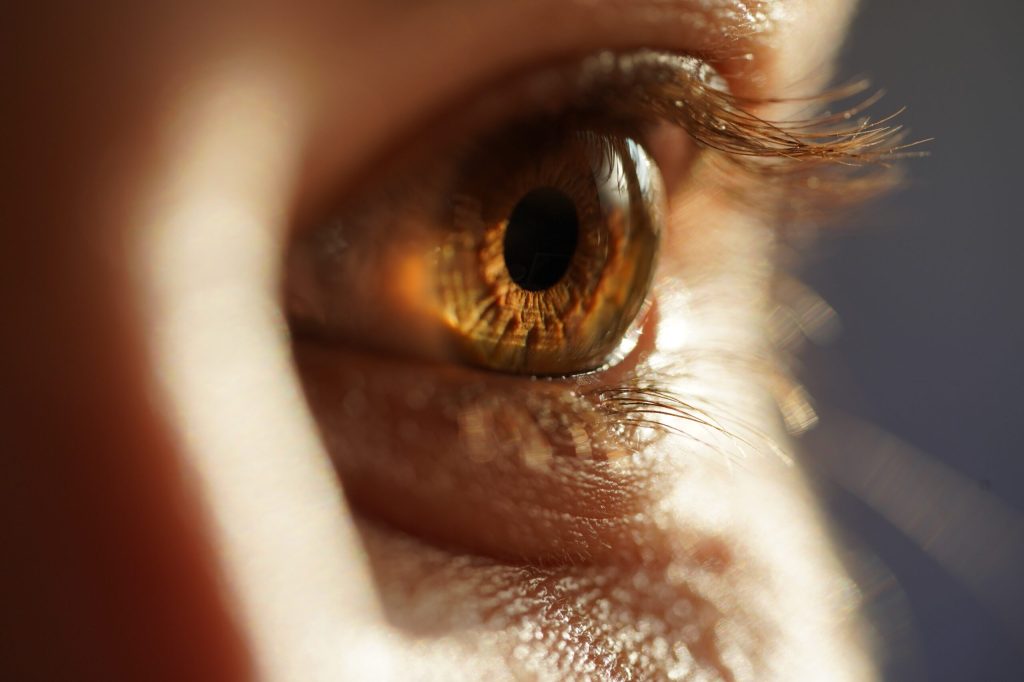
What is Age-Related Macular Degeneration? A Look at Different Types, Symptoms, and Risk Factors
February is Age-Related Macular Degeneration (AMD) Awareness month. AMD is the leading cause of vision loss in people over 50 and the disease is very common among older adults, but it can be challenging to diagnose early on. Also, treatment options tend to be limited. Read on to learn about the types, symptoms, causes, preventative measures, and available treatments for AMD.
Two Types of Age-Related Macular Degeneration
AMD results from issues with the macula, the portion of the retina at the back of the eye responsible for central vision. The two different forms of AMD are dry AMD and wet AMD.
Dry AMD is the most common, and makes up 80-90% of cases. It occurs when the macula thins over time and tiny clumps of protein accumulate. The blurry central vision that this creates progresses slowly and typically doesn’t expand to peripheral vision, which why the disease can be difficult to notice in its the early stages.
Wet AMD is much less common and more serious. It results from new, abnormal blood vessels that have grown under the retina leaking and scaring the macula. Vision loss is more severe in this case and occurs rapidly.
Symptoms of Age-Related Macular Degeneration
Some of the specific symptoms of AMD include:
- Blank spots in vision
- A blurry area near the center of vision
- Brightness of vision
- Loss of vision sharpness
- Difficulty driving or reading
- Distortion of vision—objects in the direct line of sight may appear bent or twisted into irregular shapes
These symptoms may affect one or both eyes. Because other conditions, such as Alzheimer’s disease, can also affect vision, an accurate diagnosis is key for effective treatment and should be confirmed by an eye doctor.
In addition to reviewing the patient’s medical history, a doctor may perform tests to confirm an AMD diagnosis. These could include a visual acuity test with a common eye chart, pupil dilation to examine the retina, or a non-invasive imaging technique known as optical coherence tomography (OCT). By looking at an Amsler grid, patients can test for blurry spots in the field of vision for one or both eyes that might have gone unnoticed. To asses the risk of wet AMD occurring, fluorescein angiography is used to test for the presence of abnormal blood vessels and retinal changes. Once a formal diagnosis is made, a reasonable outlook can be discussed based on the progression of the disease.
Causes & Risk Factors of AMD
There are a few common risk factors for AMD that should be monitored by caregivers and physicians. Individuals may be at a higher risk for AMD if they:
- Have a family history of AMD
- Have high blood pressure
- Are a current or former smoker
- Are over 60 years old
- Are overweight
While it’s impossible to control all of these risk factors, there are still lifestyle changes, vitamins, and other steps to take that can lower the risk of experiencing AMD. A healthcare provider may offer some suggestions based on a patient’s unique medical history and lifestyle.
Potential Treatments for AMD
There are currently no treatments available for dry AMD. With the presence of more mild, early symptoms, a healthcare provider is likely to simply monitor the progression of the disease and recommend regular follow-ups. Engaging in regular exercise and maintaining a diet for good eye health can be beneficial for people with AMD. The symptoms of later-stage dry AMD can sometimes be slowed down with vitamin and mineral supplements.
For patients with later-stage wet AMD, the damage to vision may be reduced by photodynamic laser therapy (PDT) that seals blood vessel in the retina or injections of anti-VEGF medications that reduce the number of abnormal blood vessels and slow leaking.
Preventative measures are still the best way to avoid complications from AMD. Wear UV-protective glasses to help prevent damage from the sun’s rays, schedule regular eye exams, and report any vision changes to a healthcare provider right away. Closely monitor other medical conditions such as diabetes or heart disease. Avoiding tobacco products and maintaining a healthy weight through regular diet and exercise is especially important.
While it doesn’t always result in severe blindness, age-related macular degeneration can affect vision in a way that reduces quality of life. It’s crucial for older adults to maintain and develop healthy habits that reduce the risk of developing AMD. On top of that, awareness of what the disease looks like and how to prevent it helps us take better care of ourselves and our loved ones.
More insights like this:
-

Helping an Aging Loved One Through Declining Mental Health
Read more: Helping an Aging Loved One Through Declining Mental HealthMental health challenges can impact anyone at any time of life. However, older adults tend to be more vulnerable to depression and other mental illnesses, on average, with 14% of adults aged 60 or older suffering from a mental disorder. “If you recognize or hear from a loved one that their day-to-day life is significantly…
-

Delirium vs. Dementia: Causes, Symptoms, Treatments, and Preventative Measures
Read more: Delirium vs. Dementia: Causes, Symptoms, Treatments, and Preventative Measures5 Key Things Family Caregivers Need to Know About Delirium and Dementia Onset and Course Are Key Clues That Caregivers Should Watch Closely Delirium develops suddenly (hours or days) and often fluctuates; dementia progresses gradually over months or years. Acute changes in thinking or attention should trigger urgent medical evaluation. Delirium and Dementia…
-

7 Immune System Booster Tips for Seniors
Read more: 7 Immune System Booster Tips for SeniorsThe immune system is the body’s first line of defense against viruses and infections, but the aging process can weaken the immune system. Throughout the COVID-19 pandemic, this became an increased concern for the caregivers of older or immunocompromised adults, as the risk of more severe symptoms and outcomes was much higher in these…